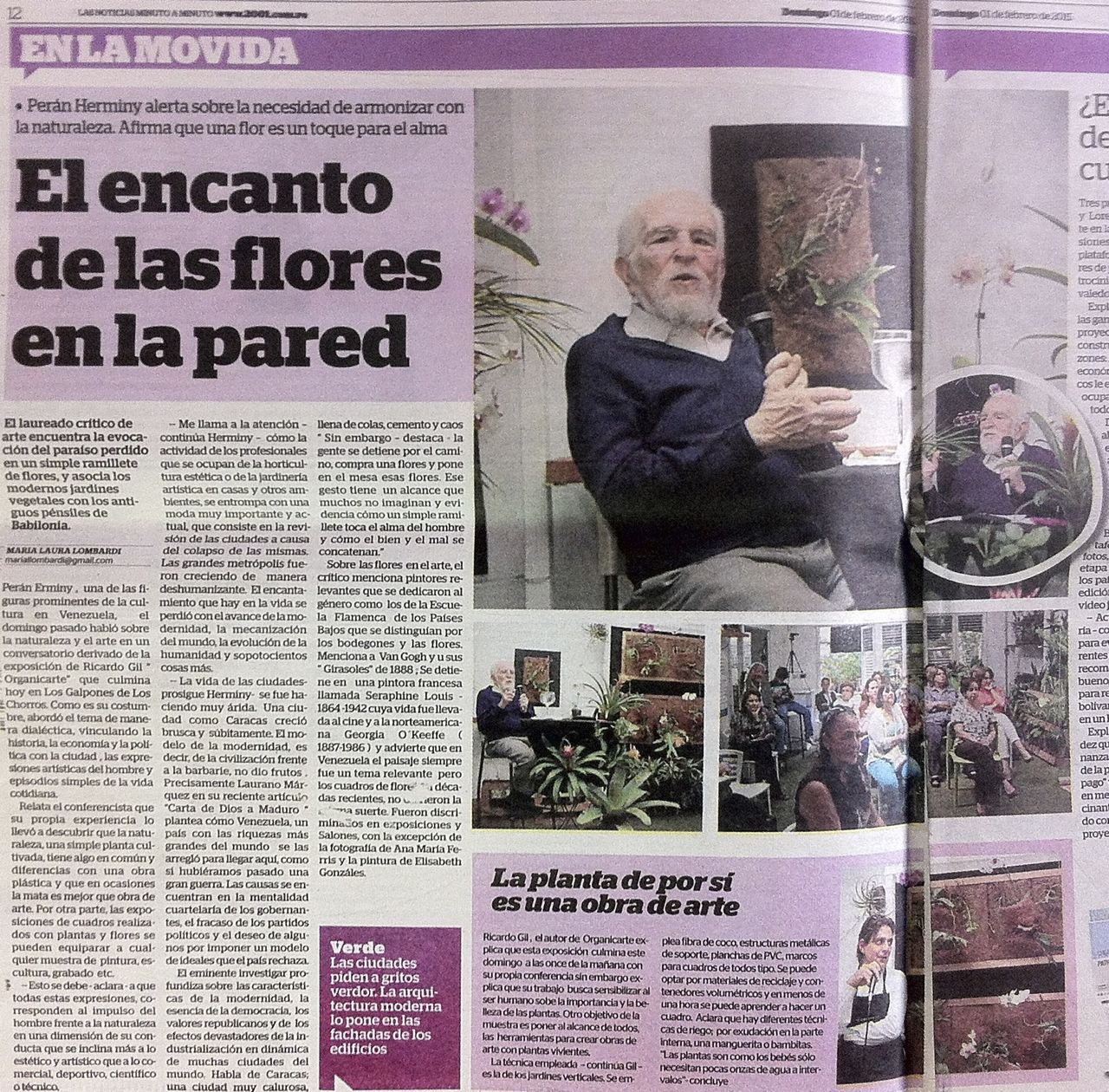Daily Newspaper 2001
Sunday, February 1, 2015,
page 12-13
Title: Charm of Flowers
Author: Maria Laura Lombardi
LAST NEWS/MINUTE BY MINUTE www.2001.com.ve
Sunday, February 1, 2015
IN THE MOVE
Peran Erminy alerts about the need to harmonize with nature. He affirms that a flower is something touching the soul.
Flowers in walls are charming.
The successful art critic finds the evocation of the lost paradise in a simple bouquet of flowers and relates modern vegetal gardens with the antique Babylon’s hanging gardens.
MARIA LAURA LOMBARDI. mrialombardi@gmail.com
Perán Herminy, one of the prominent figures in Venezuela’s culture, last Sunday talked about nature and art in a dialogue on the occasion of Ricardo Gil’s exposition “Organicarte” (Organic Art) closing today at Los Galpones de los Chorros. As it is usual in him, he treated the theme in a dialectic matter, relating history, economy and politics with the city, men’s artistic expressions and simple facts of daily life.
The lecturer stated that from his own experience discovered that nature, a simple cultivated plant, has things in common and differences with an artwork and some times the plant is better than a piece of art. On the other hand, expositions with pictures made with plants and flowers can be equivalent to any exposition of paintings, sculptures, engravings, etc.
– This is because – he explains – all this expressions correspond to men’s impulse in front of nature in a dimension of his conduct that is more inclined to aesthetics and artistic expressions than to trade, sports, science or technical expressions.
– It catches my attention –Herminy goes on – how the activities of professionals that work in aesthetic horticulture or in artistic gardening in houses and other environments, strike into a very important and current fashion that consists in the review of cities because of their collapse. Great metropolis grew in a dehumanizing way. The charm present in life has been lost with the pass of modernity, mechanization of the world, evolution of humanity and a lot of more things.
Life in cities –Erminy goes on—, became very arid. A city like Caracas grew abruptly and fast. The model of modernity, that is to say, of civilization against barbarism, did not deliver benefits. Precisely Laureano Marquez in his recent article “Letter from God to Maduro” raises how Venezuela, a country with the greatest wealth in the world found its way to become what it is today, as if we has just been through a great war. Causes are found in the Leaders’ military mentality, the failure of political parties and the wish of some to impose a model that the country rejects.
The imminent researcher goes deeper into characteristics of modernity, essence of democracy, republican values and the devastating effects of industrialization in the dynamic of many cities in the world. He talks about Caracas a very hot city, filled with car traffic, cement and chaos. “However – he emphasizes – people stop their way and buy flowers and set them on a table. This gesture has a scope that many cannot imagine and evidences how a simple flower bouquet touches the soul of men and how the good and the bad are concatenated”.
As to flowers in art, the critic talks about relevant painters who dedicated themselves to the genre as those of the Flemish School of the Netherlands that had distinctive characteristics such as their still-lifes and flowers. He mentions Van Gogh and his “Sunflowers” of 1888. He stops at a French painter called Seraphine Louis – 1864-1942 whose life was brought to movies and the American Georgia O’Keeffe (187-1986) and remarks that in Venezuela landscape has been always a relevant theme, but paintings of flowers in recent decades were not as lucky. They were discriminated in expositions and national art galleries, with the exception of photos by Ana Maria Ferris and the paintings of Elizabeth González.
Green. Cities are shouting for green areas. Modern architecture puts them onto building’s facades.
Plants are by their self pieces of art.
Ricardo Gil, author of Organicarte explains that this exposition ends this Sunday at eleven in the morning with his own conference; nevertheless. he explains that his work seeks to sensitize humans about the importance and the beauty of plants. Another objective of the exposition is to put at everybody’s reach the tools to create artworks with living plants.
The technique used –Gil goes on – is that of vertical gardens. It makes use of coconut fiber, metallic structures as a support, PVC sheets, and any kind of picture frames. Recycled objects are also an alternative and volumetric containers, and in less than an hour you can learn how to make a plant’s picture. There are also different irrigation techniques, by exudation from the internal part, a little hose or small pumps.
“Plants are like babies they just need a little amount of water ounces in intervals”, he concludes.
